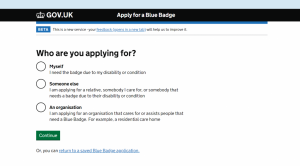A guide on how to fill out a disabled blue badge application
For anyone with difficulties when it comes to moving freely – be that a long-term disability, an illness or a mental health condition – then the acquisition of a Blue Badge can be nothing short of a godsend.
Such a badge is a visual piece of documentation – nearly always issued by the authority in which you reside or work – that can be placed in a vehicle that gives the driver certain rights; these are, most often, parking allowances.
It is worth noting that the badge, though displayed in a vehicle, is linked directly to an individual; this means that regardless of the vehicle – and whether or not the person is a passenger or driver – the Blue Badge can apply.
There is a very particular set of requirements that result in an individual being awarded a Blue Badge, and it is important to know what they are, and how a form can be filled out adequately to ensure that all those who warrant a Blue Badge can attain one.
What does a Blue Badge entitle the holder to?
There are some misconceptions around what a Blue Badge sanctions an individual to do. These entitlements are not always obvious or clear, so let’s break them down.
A Blue Badge holder can:
- Park a vehicle in a specific car park space designated for Blue Badge holders
- Park a vehicle for free on any street that contains parking meters (unless specifically mentioned otherwise)
- Park a vehicle on yellow lines (either single or double) for as many as three hours
- Ask their local council if they can have bespoke parking space position beside their home
It is also worth noting that nearly everyone able to attain a Blue Badge can also – very likely – consider themselves eligible for other entitlements, such as grants or financial donations. To find out more visit the Blue Badge Company website.
The application process
The application can be filled out either online or as a paper copy. Most people tend to consider the online form – which can be found here – to be quicker and simpler than the physical equivalent, which you can get by asking your local council. Some councils – such as Wiltshire – have recently announced that they will only accept online applications, and it is very likely that more councils, in a bid to reduce administrative work and minimise paper waste, will follow suit in the near future.
What you will need
As with all applications you will need certain things to ensure that everything goes without a hitch. It may be that your council will require particular documentation that is not needed by other councils, but in general, you will be asked for:
– Some kind of legitimate proof of your identity (a driving licence or a passport, for example)
– Confirmation of the address in which you reside (a bank statement)
– Medical documentation/forms that can be used to support your application
– A passport-style photo that can be used on your badge
It will also be necessary for you to pay a processing fee, which tends to be around £10, but this sum is liable to change, so make sure that you check the amount prior to filling out the form.
It is also worth noting that you may not have to fill out a form in its entirety in certain instances. If you are registered as being blind or have a sight impairment, for example, then you will likely be able to get your Blue Badge quite quickly.
Filling out the form
The purpose of the form is to explain why you believe you are eligible for a Blue Badge. You will need to list the reasons that mean you find it difficult to move, what disabilities you have, the level of mobility that you have, and provide any associated medical documentation to support what you are saying. You should give as much detail as possible, as this will drastically enhance your application. This may come across as somewhat intrusive, but it is simply to ensure that nobody can abuse the system.

If you are unable to fill out the form yourself then someone close to you – a partner, friend or family member – can do it on your behalf, as long as they state from the outset that they are doing this.
You should also list things such as stating the walking aids that you use either on a regular or infrequent basis, state whether you find using these difficult, and also note things such as saying how you feel when you walk, and how long you are able to stay on your feet on both good and bad days.
Do not be concerned about going into too much detail or repeating yourself – it is far better to write too much than too little.
Once you have finalised your form – it is usually worth getting someone to check it over first – then you can send it to your local authority. All of the claims tend to be process within two months but could take longer during the current period should employees have been furloughed.
If you are successful, then you will be informed directly, and you will usually be given a Blue Badge with a lifespan of three years.
If you have any questions or queries when it comes to obtaining a Blue Badge, or want to know about the process of insuring a car once you have a Blue Badge, get in touch and we’ll be happy to help.



